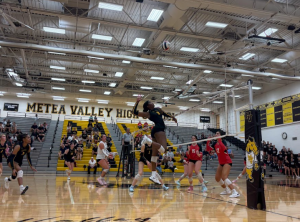February 3, 2021
For decades, Latinos have had lower voter turnout rates in American elections than any other demographic, according to The Pew Research Center. In the 2020 U.S. Presidential Election, there was uncertainty with not only the outcome of the election, but how the Latino voter turnout would affect said outcome. The electorate predicted a “blue wave,” as there was a record number of eligible Latino voters in 2020 compared to years past. The term “blue wave” was used among political analysts to explain an expected high number of Democrat votes. After the 2020 election, the assumption that all Latinos vote the same was seen as a misinterpretation of the “Latino vote.” So what does the “Latino vote” mean?
According to LatinoUSA.org, an organization that seeks to expand the narratives of Latinos, “the Latino vote can be considered a myth because Latinos are a heterogeneous group with different political preferences and values.” There are 60 million people considered Latino, all of whom come from at least 20 different ethnic and cultural subgroups.
Political opinion, for example, is a good illustration of the diversity in the Latino community. A survey conducted by the American Election Eve Poll concluded that, while 74% of Mexican Americans voted for Joe Biden and only 23% voted for Trump, only 45% of Cuban Americans voted for Biden, with the 52% majority voting for Trump.
“We have a lot of Latinos that come from similar origins, but when it is about politics and elections, everyone has their own necessities,” Merit House counselor Javier Polavieja said.
Polavieja, who is one of the sponsors of the Organization of Latin American Students [OLAS] at Metea, promotes cultural awareness and education about diverse Latino cultures.
“For Latino communities issues like immigration laws and laws relating to DACA are a top priority for many students and young families,” Polavieja said.
As the Latino population continues to grow in America, their participation in elections grows as well. While states like Texas and Florida overall voted for Trump, it was not a quick landslide. Districts with higher Latino populations played a significant part in the electoral processes of these states. Much of the attention, however, is skewed towards Cuban Americans.
Associate Professor of Foreign Languages and Latino studies at Aurora University, Eva Serrano is aware of the voter trends within the Latino community.
“When you go to Florida and talk to Cuban Americans, and now Venezuelans and even some Central Americans, they have been influenced by the media that the Republican Party better suits them,” Serrano said.
Serrano also recognizes that more Cuban Americans hold significant leadership positions in Spanish-language media companies, such as Univision and Telemundo.
“The wave of Cuban Americans back in the 1960s, when Fidel Castro took over Cuba, is when people began to leave the island,” Serrano said. “That first wave consisted of highly educated professionals. They were able to build a professionally educated social class to establish roots and power.”
This establishment has allowed Cuban Americans to create their opinions and identity which has allowed them to be more politically active.
The positions Cuban Americans hold in the media are significant. Media has a great influence on the spread of political information. Naturally, exposure to the media has transformed how many individuals vote and what issues they vote on. Social media is the most accessible outlet to receive information on political issues, especially for young adults.
The diversity of voting among Latinos is seen across age groups. The American Election Eve Poll concluded that issues addressing racial injustice and discrimination are important to Latinos ranging from the age of 18-29.
“Generation Z [individuals born between the mid-90s and early 2010s] grew up with technology, we constantly see the news about politics, so it makes sense that we have different opinions [than prior generations],”senior Valerie Zapata said.
Zapata, like many other young people who were not able to vote in the 2020 election due to age restrictions, understands the importance of her future ability to vote.
“Before, I was not aware of the severity that politics had in daily life. Now that I am older, I understand what my participation means, and what political leadership means in general,” senior Valerie Zapata said.
Not only has the 2020 election prompted young people to recognize their important role in voting, but it has sparked a conversation about the misinterpretation of the term “Latino vote”.
There was a large amount of support for incumbent presidential candidate Donald Trump in highly-populated areas like Miami, a city with a high Cuban-American population. These cities ultimately led Florida to secure Trump’s win over Biden. Meanwhile, on the West Coast, Arizona made history by ultimately voting for a Democratic candidate after over two decades of voting for Republican candidates. The largest Latino subgroup in Arizona is Mexican Americans. The Pew Research Center concluded that Latinos made 31% of the Arizona population, and 90% of those Lationos were of Mexican origin.
“I believe that the Latino population is more aware of what they want people in power to do to support their needs, which has caused people to be more civically engaged,” Polavieja said.
Generation Z had a notable effect on this election, as a portion of this generation was able to vote for the first time. The Center for Information and Research on Civic Learning and Engagement estimates that 52%-55% of youth voted in 2020, and that the support many younger individuals, especially individuals of color, had on the election decided many key races.
“Some people might call [the turnout of young voters in the Election] an awakening, but it cannot be temporary,” Serrano said. “What I see in young people is that they are starting to see that their voice matters. Many more are understanding that change comes when you engage.”
In addition, Serrano, who is not a stranger to analyzing the history of Latino voters, agrees that the fallacy of one unifying “Latino vote” prevents people from understanding the diversity within Latino voters.
“If it [Latino vote] is used to represent one perspective of the Latino community, then it is not valid,” Serrano said. “We have to be able to deconstruct that myth that we all vote the same, we all speak Spanish the same, and that we all have the same history.”







